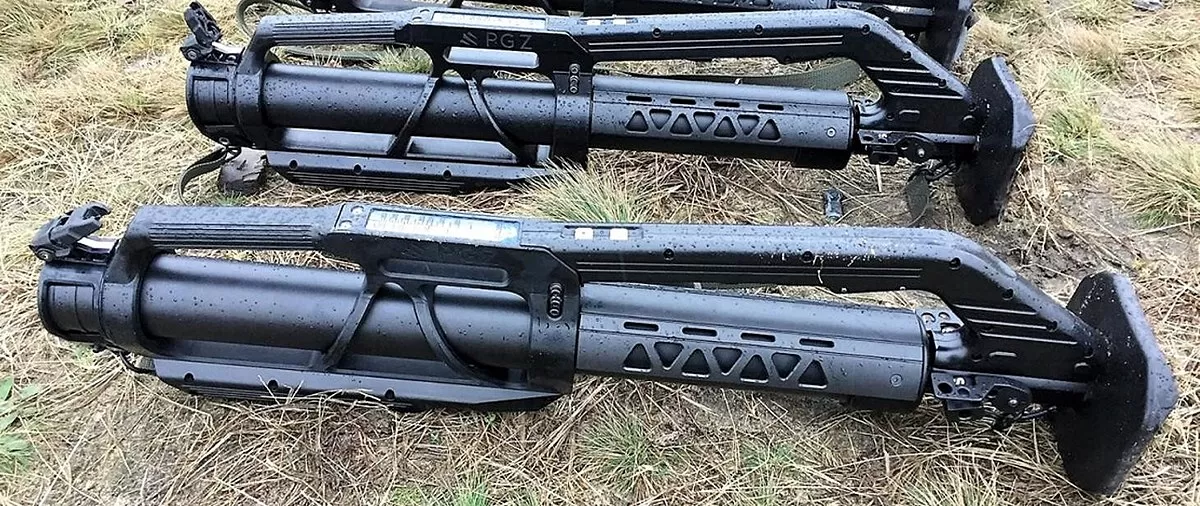
LMP-2017
LMP-2017 in all its glory - clearly visible from under the locking plate and top handle.
The period after the end of MSPO 2017 was the time of refinement, testing and public premiere of the latest 60mm mortar, created by Zakłady Mechaniczne Tarnów SA. This new weapon, developed in accordance with the requirements of the Territorial Defense Forces, is a good example of the accuracy of the thesis that the mortar is light artillery with high losses.
The September issue of Wojska i Techniki (WiT 9/2017) describes the latest 60mm mortars developed by ZM Tarnów SA, their significance and advantages on the modern battlefield. However, in Tarnow, work was already underway on a completely new mortar, designed based on the requirements and needs of the Territorial Defense Forces. We are talking about LMP-2017, that is, Light Infantry Mortar Mk. 2017. The first functional prototype - a technology demonstrator - was shown in action at a private exhibition in October. However, the current LMP-2017 is quite different from this model. First of all, it should be noted that the expectations of the IVS were for a commando mortar, without support and therefore mainly for semi-aimed fire, as light as possible, ergonomic and comfortable, easy to use and effective even when used by a single soldier.
Anatomy LMP-2017
The performance requirements for the LMP-2017 and its ammunition are based on the NATO standard STANAG 4425.2 (“Procedure for determining the degree of interchangeability of NATO indirect fire ammunition”), hence the 60,7 mm caliber and 650 mm barrel length. . Although there were no decisions regarding the target caliber during the work on LMP-2017, we already know today that the Polish Army (including TDF) is leaning towards the 60,7mm caliber.
An important issue, deciding the issue of a compromise between the strength of the mortar and its weight, was the choice of materials for its manufacture. Currently, LMZ-2017 is made from the following materials: dural thrust plate; titanium breech with duralumin or steel parts for greater resistance to shot forces; duralumin sight; polymer body and bottom bed; steel stem. Thanks to this, the LMP-2017 weighs 6,6 kg. Two other prototypes were also built for comparison. One had a steel breech body, a duralumin stop and a similar mortar body and steel barrel. Weight is only 7,8 kg. The third option had a duralumin body with a thrust plate; steel parts of the barrel and breech, the body of which was titanium. The weight was 7,4 kg.
A very important element of the LMP-2017 is the steel barrel, which has been reduced in weight compared to previous 60mm mortars from Tarnow. The new barrel weighs 2,2 kg. The LMP-2017 barrel cable is protected from the destructive action of powder gases by a coating obtained by gas nitriding, instead of the technical chromium coating used so far. Its minimum life, guaranteed by the manufacturer, is 1500 shots. The pressure in the barrel when fired reaches 25 MPa.
The LMP-2017 uses a liquid gravity sight. The sight scale has two types of illumination, visible and infrared, for use when using night vision surveillance devices. The button for switching lighting modes is located in the handle under the sight. In the case of work in the dark, the selected level of illumination of the sight scale protects the face of the soldier operating the LMP-2017 from illumination, and thus reveals the position of the mortar. Slots for pumping and refueling are located above the sight. The gravity sight is complemented by a folding mechanical sight placed at the muzzle of the barrel. Currently, this is an American sight Magpul MBUS (Magpul Back-Up Sight) in the form of an open front sight. It is used for rough aiming of the LMP-2017 barrel at the target to speed up the production of a shot. After capturing the target in the MBUS, the distance setting is stored in the liquid sight built into the upper handle of the LMP-2017. Looking up from the gravitic sight scale, you can see the target through the MBUS, which allows the firing soldier to independently adjust the fire depending on how the shots are located in relation to the target.